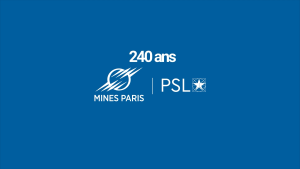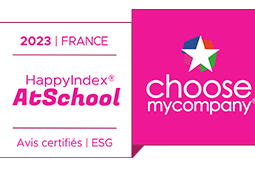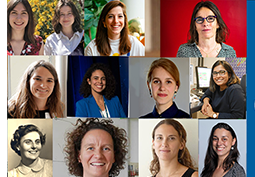



 Lecture
Lecture
Bio-based aerogels: new eco-friendly porous materials for thermal insulation and controlled release
The LASAT (Laser Shock Adhesion Test) represents a promising alternative to support manufacturers of biomedical prostheses in their process / product developments, entering market. A LASAT method must be developed on biocompatible deposits in order to best respond to the problems associated with the implementation of a fast and robust adhesion test that is expected to be standardized in a near future. The thorough study of biocompatible deposits submitted to laser shock debonding must allow the optimization of a LASAT protocols and the characterization of phenomena impacting the mechanical strength of interfaces in relation to the control of industrial manufacturing processes. The study of the feasibility of the technique on various industrial biomaterials, the choice of a complete and transferable test protocol will be supported by the carrying out of cross-evaluations by various methods of measurement or calculations of interfacial mechanical strength. The study of the robustness (repeatability and reproducibility) and the reliability of LASAT will be the main indicators of this study which would lead to the definition of a new demonstrator.
The Laser Metal Deposition process, or LMD, is a rapid free form fabrication method which can be used to manufacture new near net shape metallic components, to repair used metallic parts or to add functional parts on existing ones. During this process, a carrier gas is used to form a powder stream which is fed into a molten pool created by a laser beam on the top surface of a metallic substrate. The delivery system is a nozzle whose configuration and size depend on its manufacturers.
One of the challenging issue of this process is to fully understand the impact of all its manufacturing parameters and to be able to estimate properly the geometrical and metallurgical dimension of the different deposits. This would strongly limit the time and cost of manufacturing parameters development which needs to be done for all new component. If many analytical, empirical, or numerical models have been developed over the years, none of them take an active interest in the impact of the nozzle delivery parameters such as its size, its configuration and the gas and powder particles characteristics which flow through it. Then, the developed models cannot be transpose from one nozzle to another and the parametric study of one component must be develop again.
The purpose of this study is to improve existing models by adding some nozzle parameters linked with the laser-matter interaction to be able to transpose a parametric study from one nozzle to another. To complete this project, a numerical simulation and different experimental setup will be used to better understand the impact of nozzle parameters.
Described by some as a "new industrial revolution", additive manufacturing technologies are increasingly present in the aeronautics and space sector, given the financial stakes, technological advances and environmental impact of these processes. With a permanent aim to reduce the development stages of parts, costs and lead times, to reduce the overall energy footprint of the production line compared to "subtractive" processes, the aeronautical and space industry and in particular ArianeGroup has high hopes in these rapid manufacturing techniques. Some companies are even thinking about large-scale implementation of these new technologies in factories of the future known as 4.0. However, certain phenomena of these processes and in particular laser-material interaction are still poorly controlled and not fully understood.
The PALOMA project is working to consolidate the entire production chain, from powder to piecework, with a view to the imminent industrialization of certain parts. In fact, this project focuses on the development and improvement of two additive manufacturing processes, Selective Laser and Electron Beam Melting of metal powder beds. It follows on several major structuring projects such as PROFILE and FALAFEL initiated by the GIFAS (Groupement des Industries Française de l' Aéronautique et du Spatial). PALOMA's objective is therefore to continue developing this manufacturing technology from a pre-industrial to a fully industrial stage in order to develop structural parts with good metallurgical quality. The innovation of this project is based on the provision of an open machine, allowing the measurement of the thermal fields during manufacture. By these methods, we will try to understand laser-powder bed interaction and defect genesis. Using an on-line process control will allow the detection, identification and quantification of defects in the part volume. The main material of this project remains TA6V, but a stainless steel is also considered.
The subject of this PhD concerns additive manufacturing of parts made out of nickel-base superalloys for the aeronautical sector. These materials are relevant for the parts of plane and helicopter engines that reach very high temperatures in operating conditions. For next-generation engines, Safran Group is considering using the Laser Beam Melting (LBM) process to manufacture pieces in Inconel 738. This alloy is made of an austenitic γ matrix reinforced by a high fraction of 𝛾′ - Ni3 (Al,Ti) precipitates, that confer interesting mechanical properties at high temperatures but that also complicate its shaping by the LBM process. The alloy endures high thermal gradients during its melting by a laser source and often cracks during fabrication or during further heat treatments. Similarly to the Inconel 738, some high performance materials (materials with low weldability) are currently not eligible to Laser Beam Melting fabrication.
The goal of this work is to better understand the cracking mechanisms of the Inconel 738 and to propose a fabrication method suitable for these cracking-sensitive materials. Several complementary approaches will permit to reach that objective. First, different fabrication conditions with the LBM process and different heat treatment conditions will be explored. A novel multi-laser machine (patented and developed by the Centre des Matériaux) will allow new fabrication strategies, with a higher control of the cooling rate and of the thermal gradient. It is equipped with an in-situ monitoring system that will be an asset to understand the formation of cracks and to propose relevant fabrication strategies with one or two lasers. Secondly, microstructural characterizations will permit to understand the link between precipitation of hard phases (like carbides and borides), stress relaxation and cracking mechanisms. This understanding will be enriched with the study of alloys with close compositions, as René77. Last, numerical simulation of the process – in partnership with the CEMEF – will enable to access some data which are not directly measurable with the instrumentation, as the thermal gradient at the bottom of the melt pool. As cracking is known to strongly depend on the design of the parts, a particular attention will be given to using geometries that are representative of industrial pieces, with a high stress concentration factor.
As a conclusion, this work will participate in making more high performance materials eligible for an additive manufacturing.
Nowadays, industry continually needs to reduce the manufacturing steps of parts, costs and lead times as well as the ecological footprint of manufacturing lines. To meet these challenges, mechanical industry has placed great hopes in additive manufacturing in recent years.
However, some aspects are still poorly controlled and understood, such as the development of the microstructure under severe conditions of thermal gradients and solidification rates for the Selective Laser Melting (SLM) of powder bed.
Aim of the PhD is to understand and control microstructure induced by SLM process in order to obtain as-build parts with expected metallurgy.
Additive Factory Hub (AFH) was inaugurated on December 2017, and located in Digiteo-Saclay (CEA Paris-Saclay center). The AFH platform is in charge of structuring the industrial ecosystem in additive manufacturing around the research players of the Paris-Saclay and Île-de-France Campuses to meet the major industrial and economic challenges.
Additive Factory Hub's members and partners are: AddUp, Air Liquide, AREVA NP, Arts et Métiers ParisTech, CEA, CETIM, CNRS, Dassault Systèmes, ENS Paris-Saclay, EDF, LNE, MINES ParisTech, Onera, Poly-Shape, Safran, SystemX, Paris-Saclay University, Paris-Sud University, Vallourec.
Compared to other ceramic additive techniques, laser beam melting (LBM) provides direct near-net shape manufacturing, offering simultaneous melting and shaping. Post-processing and machining costs are consequently limited. It offers new shape and microstructure possibilities for complex high strength and temperature resistant structures, needed for example, to improve thermal efficiency of turbomachines. Ceramic LBM has been delayed due to material poor absorptivity in near infra-red wavelength, along with weak thermal shock resistance. Those main issues can be overcome, with addition of a sorbent to ceramic powder and by using preheating systems. High thermal gradients and cooling rates are generated, which enable directional solidification of nano-scale eutectic microstructures, known for their creep resistance.
The effects of process parameters, sorbent nature and content on powder bed properties and melted track stability are investigated. Track shrinkages and powder particle ejections after consolidation by melting are also assessed. These observations are correlated to optical properties. Laser-interaction models based on the analysis of volume interaction are developed. In-operando spectrometric measurements are also performed, in order to monitor the evolution of materials properties during manufacturing. Consequently, optical properties are traced not only at room temperature but also at high temperature, corresponding to solid powder bed and liquid fused material states. Ultimately, process parameters and criteria for stable dense 3D part manufacturing are identified. Proof is made that laser interaction with ceramics shows large differences compared to metals.
Additive processes involving the melting powder bed or the spraying of powders are used to manufacture or to repair industrial parts. The powder is deposited incrementally in layers, and generally steep thermal gradients are generated during the cooling down leading to non-equilibrium state of the material. Generally, the free edge surfaces exhibit different microstructural, metallurgical, and morphological characteristics if compared to the bulk. Therefore, post-treatments can be considered to better control the features of the surface. This issue about the finishing surfaces in the additive manufacturing route is crucial for the life of the parts. Functionalization of the surface by a coating can also be envisaged.
In this thesis work, we aim to extend the knowledge of the specific characteristics of the surfaces of materials resulting from "powders" processes (cold spray or LBM), as processed or post-treated mainly using impact surface treatments like for example laser shock, cold spray and dry ice treatment with facilities that are available in the laboratory. Surface characterization will include the microstructural and morphological assessments of the surfaces but also the mechanical using XRD analysis of residual stress. Numerical tools are also envisaged to help the prediction of the material’s behaviors under impact processes. This exploratory study will concern the case of pure alloys (Al base, Ni base typically) to develop the methodology, but could extend eventually to other materials including bi material composites or other alloys for industrial purposes.
[1] V. Champagne, D. Helfritch, P. Leyman, S. Ahl, et B. Klotz, « Interface material mixing formed by the deposition of copper on aluminum by means of the cold spray process », J. Therm. SPRAY Technol., vol. 14, no 3, p. 330‑334, sept. 2005.

Ecole
240 ans de recherche et de formation
Vidéo : 240ans de recherche…
> En savoir +
Recherche
Prix Jean Mandel 2023 mécanique des matériaux
Le prix Jean Mandel décerné tous les…
> En savoir +

Formation
Samuel Forest, élu membre de l’Académie des…
Samuel Forest lors de sa réception à…
> En savoir +

Formation
Mines Paris plébiscitée par ses étudiantes
Mines Paris - PSL, une école qui répond…
> En savoir +

Formation
Femmes de science
Chercheuses confirmées, doctorantes, élèves ou alumni,…
> En savoir +

Formation
Quelle école d’ingénieurs a le…
Mines Paris - PSL au Top 5 du classement LinkedIn 2023…
> En savoir +
